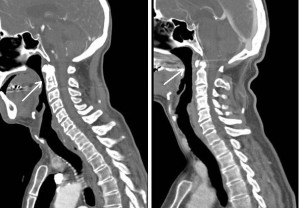Smrčanje sploh ni smešno. Nikakor za tistega, ki mora ob sebi trpeti smrčača. Za samega smrčača pa je lahko smrčanje, zaradi prenehanja dihanja, posledično celo smrtno nevarno!
Članki
Smrčanje je v bistvu kričanje na pomoč
02 maj
Smrčanje ni povsem nedolžna stvar in se stopnjuje, zato je pomembno vedeti, kdaj nastopi trenutek, ko je vendarle treba stopiti k zdravniku na posvet.
Proučevanje smrčanja
24 okt

CT slika osebe, ki smrči (levo) in osebe, ki ne smrči. Puščici kažeta prostor za mehkim nebom, ki je pri smrčanju zožen.
Snoring Imaging – Could Bernoulli Explain It All?
Igor Fajdiga, MD, PhD
CHEST. 2005;128(2):896-901. © 2005 American College of Chest Physicians
Abstract
Study Objectives: To identify upper airway changes in snoring using CT scanning, to clarify the snoring mechanism, and to identify the key structures involved. Participants: Forty patients underwent CT examination of the head and neck region according to snoring habits; patients were classified into nonsnoring (n = 14), moderately loud snoring (n = 13), and loud snoring (n = 13) groups.
Design: Comparative analysis.
Measurements: Using CT images, areas, the anteroposterior and transversal distances of the pharyngeal space at different levels, and the thickness and length of the soft palate and uvula and their angle against the hard palate were measured; evidence of impaired nasal passages was noted; the extent of pharyngeal inspiratory narrowing was the ratio between the area at the hard palate level and most narrow area; and expiratory narrowing was the ratio between the area behind the root of the tongue and the most narrow area.
Results: Greater pharyngeal inspiratory narrowing (p = 0.0015) proportional to the loudness of snoring (p = 0.0016), and a longer soft palate with uvula (p = 0.0173) were significant for snoring. Impaired nasal breathing was significantly related (p = 0.029) only to the loud snoring group. The body mass index and age of snoring persons were also significantly higher.
Conclusions: Snoring is associated with typical changes that can be revealed by CT scanning. Greater pharyngeal narrowing is the most important factor. Given the “Venturi tube” shape of the pharynx, the Bernoulli pressure principle plays a major role in snoring. The key structure in snoring is the soft palate: it defines the constriction and is sucked into vibrating by negative pressure that develops at this site. Its repetitive closures present an obstruction to breathing, producing the snoring sound, and should therefore be the target for causal treatment of snoring. Obstacles in the upper airway that increase negative inspiratory pressure could not be confirmed as important for the development of snoring, although they may increase its loudness.
Design: Comparative analysis.
Measurements: Using CT images, areas, the anteroposterior and transversal distances of the pharyngeal space at different levels, and the thickness and length of the soft palate and uvula and their angle against the hard palate were measured; evidence of impaired nasal passages was noted; the extent of pharyngeal inspiratory narrowing was the ratio between the area at the hard palate level and most narrow area; and expiratory narrowing was the ratio between the area behind the root of the tongue and the most narrow area.
Results: Greater pharyngeal inspiratory narrowing (p = 0.0015) proportional to the loudness of snoring (p = 0.0016), and a longer soft palate with uvula (p = 0.0173) were significant for snoring. Impaired nasal breathing was significantly related (p = 0.029) only to the loud snoring group. The body mass index and age of snoring persons were also significantly higher.
Conclusions: Snoring is associated with typical changes that can be revealed by CT scanning. Greater pharyngeal narrowing is the most important factor. Given the “Venturi tube” shape of the pharynx, the Bernoulli pressure principle plays a major role in snoring. The key structure in snoring is the soft palate: it defines the constriction and is sucked into vibrating by negative pressure that develops at this site. Its repetitive closures present an obstruction to breathing, producing the snoring sound, and should therefore be the target for causal treatment of snoring. Obstacles in the upper airway that increase negative inspiratory pressure could not be confirmed as important for the development of snoring, although they may increase its loudness.